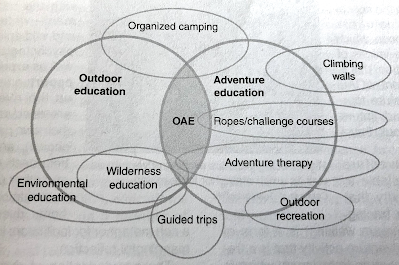Outdoor Education
Hunt (1989) states that OE is gaining direct experience in the environment by using its resources as learning materials to approach educational objectives. Priest (1986) proposed that outdoor education was founded on six major principles:
1. OE is a method
2. It requires experiential learning (based on ideas from Dewey and Rousseau)
3. Learning occurs in an outdoor setting
4. Learning takes place in three domains (affective, cognitive and motor)
5. The nature of the curriculum is interdisciplinary
6. Many relationships are a matter of education.
Experiential learning and education (principle 2) are defined as a belief that educators and learners purposefully engage in direct experiences and focused reflections in order to clarify values, develop skills, increase knowledge and actively engage with community development (Martin et al, 2017 and AfEE, 2020 - see link). Priest (1988) later presented and elaborated on these six principles above (including the experiential learning process) through his model of OE (see Figure 1).
Figure 1 - Model of Outdoor Education (Priest, 1988, p. 23-25)
OE is proposed to be a combination of ecological relationships, interpersonal growth or educational skills and physical skills through direct experience (see Figure 2).
Figure 2 - Model of Outdoor Education (Gilbertson et al, 2006, p. 6).
Higgins and Loynes (1997) and (developed further by) Higgins and Sharp (2003) present a similar model to that of Gilbertson et al (2006) by claiming that environmental education, outdoor activities, and personal and social development all contribute to OE. Gilbertson et al (2006) model seem to agree with the earlier work of Higgins and Loynes (1997) who claimed that OE must have an educational element that contributes to personal and social growth, themes that include the outdoor and adventure, learning through an experiential process (direct experience), and increased awareness of ourselves, others, the community and our environment.
Outdoor Adventure Education
Based on the models of OE, it is evident that OAE is closely linked, and is considered to be one aspect of OE (Priest, 1988 and Gilbertson et al, 2006). Wagstaff and Attarian (2009) state that the activities in OAE pose a risk and challenge to participants as they develop intrapersonal and interpersonal relationships. OAE is conducted physically in a wilderness or nature setting to promote interpersonal growth and enhance motor skills whilst engaging in outdoor pursuits (Gilbertson et al, 2006). This is elaborated further by Gair (1997) who claims that OAE is a combination of nature, self and others. The ‘self’ is concerned with personal growth and understanding, ‘others’ refers to unleashing the potential of the group through an expedition that may require physical and social demands. ‘Nature’ is the setting and an opportunity to develop environmental awareness throughout the collective experience. However, Prouty et al (2007) declare that OAE is active, engaging and has real-life learning experiences that involve the whole person with actual consequences. Prouty et al (2007) make no mention of setting and this is where OE, OAE and the term AE can cause confusion, as a multitude of outdoor adventure centres and indoor facilities such as climbing walls, ropes/challenge courses and abseiling are increasingly commercialised (Loynes, 1998). As such, it can be difficult to determine exactly where one term begins and ends, as can be seen in Figure 3.
Figure 3. The Intersection of OAE (Ewert and Sibthorp, 2014, p. 29)
Physical Education
PE is no different from OE, OAE and AE in the fact that the subject/term is viewed in different ways (Kirk, 2010 and Griggs and Petrie, 2018). Kirk (2010, p. 1) states that ‘PE is defined by what is said, done and written in its name, as are all school subjects and university disciplines’ (as they were socially constructed). PE is often synonymous with sport and viewed as the teaching of skills for competitive team sports (Penny and Evans, 2005; Houlihan and Green, 2006; Pope, 2011 and Coulter and Ni Chróinín, 2013). Furthermore, as previously stated, the purposes of PE can be seen as preparing young people for healthy lifestyles (Powell, 2018), fitness (see link) and/or education (Griggs, 2018 and Carse et al, 2020).
Coulter and Ni Chróinín (2013) conducted research to discover what pre-service teachers thought PE was and found that sport and health discourses were the most prominent responses. In conclusion, the authors stated that sport is the 'what', and health is the 'why' of PE (Coulter and Ni Chróinín, 2013). Interestingly, Outdoor and Adventurous Activities (OAA) is an area of PE within the National Curriculum (NC) and this is where each term becomes intertwined. There are many definitions and views about PE and what it does, which is a continuous debate that has continued for more than sixty years (Kirk, 2010 and Casey and Larrson, 2018). Rather than adding a number of additional definitions, further reading can be found here in relation to PE (and here in direct relation to OE). The next section of the blog shall turn its attention to current policy and practice in schools, as this is what the children come to experience and either know or not know as OE, OAE, AE, PE and OL.



No comments:
Post a Comment